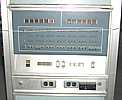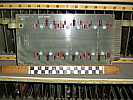A GE-225 is found
(The first machine I was paid to play with ;-))
Table of Contents
|
Background
Images and comments about: On-Line Documents |
|
The General Electric 225 (introduced about 1960) was the first digital computer that I
was paid to work on (or play with depending on your view point.) One's first computer
is a bit like one's first love or dog ;-)) Here are some tales of
that adventure.
For about 8 years I have kept my eyes open for General Electric "Computer Department" computing equipment. Lurking about the Computer History Museum in Mountain View, California helps keep one focused and is a center of activity. The first computer manufactured by the "Department" was the "ERMA" under contract to Bank of America. The initial tube design of a fixed program machine was made by SRI (now Stanford Research Incorporated) and "modified" "by the good folks at G.E." (an advertising slogan at the time) into a transistorized general purpose computer. (It did have one very special instruction - the "tumble instruction" designed to help sorting. It had 3 or 4 operands and could well be an example of a "complex" as opposed to "RISC" instruction.) One of the original 30 machines is on display at Bank of America's private museum in Concord, CA. The next was a contract to manufacture (and provide support for) the NCR 304. Nothing further was located by anyone that I know of for five years, and several General Electric "Computer Department" reunions. |
One is found, 2006, w permissions
|
On July 6th, 2006, Peter Volk - Assistant Collection Manager
of the Queensland Museum
(South Brisbane, Australia, phone +61 (0)7 3840 7555) e-mailed me
saying that there was a GE-225 in good condition in that institution.
He asked if I could verify the identification of various components,
and sent images of that machine.
Image permissions |
|
Peter Volk here, from Queensland Museum.
Yes, the GE225 is still sound and safe in our collection. The 2011 floods didnít come anywhere near it, and it has been well housed and secured. Is it for sale or exchange? In practical terms, probably not. It was the first digital computer in Queensland and is considered a significant part of the stateís history as a consequence. We value it more for that association than we do for its technical significance, though that is, in itself, considerable. We would need to be offered a really significant sum to consider parting with it, or be offered an object that had equal significance to Queensland history. If you wish to make a formal inquiry about the possibility of purchase or exchange, you should contact our museums C.E.O. Dr Suzanne Miller [e-mail address deleted] , who would forward the inquiry to staff for proper assessment and report before she replied. That report would probably require us, in turn, to contract with an accredited valuer of such objects to give us a ballpark dollar value, which would require us, first, to find such a person. The whole process between initial inquiry and final response could take a few months. The Queensland Museum is a government funded and operated museum, and is charged by Act of Parliament to collect and preserve material of significance to the history of Queensland. This means that, even if the financial offer was very, very attractive we may find ourselves unable to ethically or legally accept it. That is an assessment that would be made at a paypoint considerably above my own. If you wish to make such an inquiry Iím happy to give you what advice I can. Iím still quite grateful to you for the context and history info you provided me on the GE225ís a few years ago. Sincerely
Peter Volk
PO Box 3300 | South Brisbane BC | Queensland 4101 | Australia
|
Unit History
From Queensland Museum Record Sheet - Historical Database H-20734-1
Planning for a large computer for Brisbane began in 1957. The G.E.225 was installed at the university in 1962, the first large
computer in Old. Last operated 16 February 1977. Data specifications received with donation.
From lecture given by Wilber Williams on "History of I.T. at Old Uni" in 2002.:
The last job on the G.E. was run by Prof. Sydney Prentice on the 16/2/1977, between 16:25 and 16:30. The job card is
preserved at the University. The computer was purchased in 1962 for 148,000 pound, plus 8000 pound to aircondition the
building. The original and primary purpose of the computer was to help calculate transformer designs. The GE was replaced
as the University's major machine areound 1968 by a DEC PDP 10, for the sum of $620,000.00, but the GE remained in use
until 1977. The DEC itself was decommissioned in 1984. (It is rumoured that the reason the GE remained in use so long was
that the University payroll system was kept on it, and nobody wanted to risk a migration.) - P. Volk 16/6/2003
Denis Bainbridge writes
AGE was Australian General Electric. We were the Australian sales and support office for GE Computer Dpt.Phoenix AZ.
The University of Queensland was the first 225 system sold in Australia.
The Bank of NSW was the next customer with a 225 and two sorters. Later adding a 235 with another sorter. A photo of
this site attached. Only thing left from these computers is CPU console.panel and a memory core stack.
Cheers
Denis Bainbridge
I had forgotten, the model number of this machine, Peter responded with
So this machine seems to be an IBM 523, and this image may just be the best of an IBM 523 on the web.
In any case, the IBM 523 was extremely reliable - the most trouble free
peripheral (by far) in the GE 225 system. The GE instructors basically said -
"This 523 works well. We have shown you the GE drive circuits for the
punch magnets and clutches, and this is the big grey ugly 'shoe connector' to the machine,
that is all you need to know. OH yes, don't forget the 80-80 plug panel!"
Images Copyright of the Queensland Museum. Used by permission.
And Cables (hopefully under the raised floor :-)) and floor frames
And the Infamous Elliott Card Reader
For a less polite discussion of this little devil, click here.
The little grey assembly with yellow and red wires is likely the array of
12 lights to send light through card holes to an array of 12 photosensors
below the moving card. For some reason this assembly was removed from
it's place just before the top feed roll? The 12 volts lights were not driven hard (maybe 9 volts)
and "never" failed. Hole sensing was almost the only thing on this machine that worked
reasonably well.
In any case, the upper part is the input hopper,
not visible in the seemingly 2.5 pound cast iron block
with handle that pressed the cards down against the
bottom plate that - oh - you don't want to know -
Also wrapped about the input hopper is the connecting cable.
In any case, the metal gadgetry nearest you is the exit of
the cards into the output hopper discussed (or cussed) below.
That funny little gray finger thing is several layers of
feeler gage stock, maybe 0.002 inch thick,
whose purpose is to push the cards flying out of this
machine into the output hopper in an orderly fashion.
Just above the shim stock is a little adjustment screw
that you diddled to try to get the cards to go correctly
into the output hopper, with out:
It was easy to despise this machine. What a pile of poop!
This card reader was, I feel, one of the
main reasons that the only customer that re-ordered
General Electric Computer Department equipment was
the U.S. Army (Huntsville) - and they were using mostly paper tape
in their Saturn data logging application.
The G.E. marketeers and salesmen, to this day, refuse to admit that
an almost zero re-order rate had anything to do with the failure of the
G.E. Computer Department. They just smile and blather on about financing machines.
Dear Friends - there should be a special place in Hell for
who ever designed this part of the nightmare card reader.
To get cards out of this hopper, the operator pulled on the
little handle on the other side. As the operator pulled this
little tray out, the triangle thing you see would be pulled out
to 90 degrees from its present position, and try to catch the
cards falling down into this output hopper, making a temporary
bottom to the hopper while the output drawer was pulled out.
When the operator pushed the drawer in again, this temporary bottom
would disappear, permitting the cards that had dropped on the top
of this little flap to fall to the bottom of the drawer.
If the above is confusing and weird - you are correct.
Horrible things could happen until you got the knack of it.
You were well advised to stop the computer while
you removed cards from the Elliott !!!
Images Copyright of the Queensland Museum. Used by permission.
Circuit Cards
For comments, e-mail Ed Thelen ed@ed-thelen.org
History, Use & Ownership:
Auxilary Arithmetic Unit - AAU,
Hi Ed

H-20734-6 Card Puncher.jpg
The GE system pictures show other vapour-ware card punches,
but this is what we had in service in the early 1960s

H-20734-11 Punched Card Reader.jpg
F.E.s and operators diddled this screw so much that
the little threads failed - and more robust nuts and screws
were substituted.

H-20734-10 Card Feed Chute.jpg








-t.jpg)















